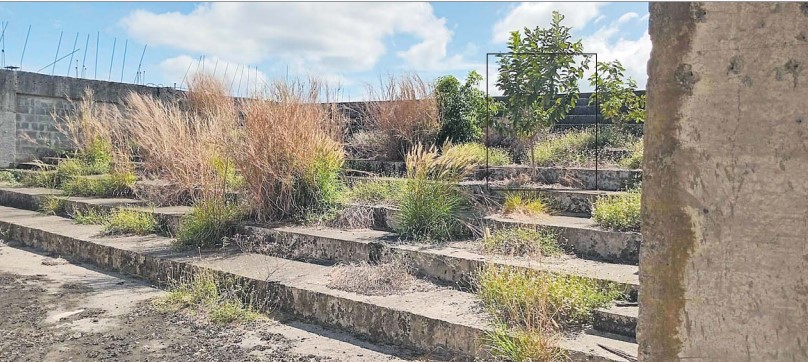Former Fiji National University (FNU) vice-chancellor Professor Nigel Healey says FNU’s failed Naiyaca Campus project in Labasa was ‘complicated from the outset’.
Prof Healey, who led FNU between 2016 and 2019, broke his silence last week, responding to The Fiji Times questions on the project, where as much as $20million has been spent with site sitting half-built.
In a written statement last week, Prof Healey described a series of problems with the project, which FNU first announced in 2015.
They included a flood-prone location, slow decision-making, a cash-strapped contractor, bad weather and the onset of the Covid-19 pandemic.
Prof Healy described the project as “a key part of the former FijiFirst government’s plan to revitalise a once prosperous city”.
“Taken together with the development of the adjacent Damodar City shopping complex, these two major infrastructure projects would have bought employment and income to the city, while at the same time making higher education more accessible to the young people of Vanua Levu,” he said.
“The Labasa campus was fully funded by annual capital grants from the government and the project was overseen by the Construction Implementation Unit (CIU) of the Ministry of Economy, whose team attended the monthly project meetings.
“As per the ministry’s protocols for major capital projects, CEESOL (Civil and Environmental Engineering Solutions Ltd) was appointed as the lead (coordinating) consultant, which managed the various design and engineering consultants,” Professor Healey said.
Prof Healey described the project as “technically complicated from the outset”.
“The land that was allocated by the Government for the new campus was in the floodplain of the Labasa river,” he said.
“(The land) required major earthworks to create a raised platform, with reinforced side retaining walls, to ensure the buildings would be above worst-case flood levels.
“This exercise took several years to complete before construction of the buildings could begin in 2018.”
Prof Healy said a series of events also contributed to the slow demise of the project.
These included flooding on the site during heavy rain. This delayed construction of the retaining walls and digging of foundations for the buildings.
He said the project suffered from “stretched supply lines” because most of the main contractors were based in Viti Levu.
Prof Healey claimed that Fiji Roads Authority (FRA) delayed making decisions about the required height and scale of access roads to the campus, which also contributed to construction falling behind timetable resulting in the termination of the main construction contract with Kartika Construction Plumbing Services Ltd (KCPL).
“In the final analysis, however, Kartika (Construction Plumbing Services Ltd), the construction company, experienced growing cash flow problems, exacerbated by poor weather, which led to them delaying payments to their subcontractors.
“The project fell so far behind schedule that Kartika’s contract was terminated in 2020, a difficult decision that followed due process after a series of formal warnings,” Professor Healey said.
Prof Healey’s three-year term ended in the same year as the Covid-19 pandemic struck the country.
He said he understood the Covid-19 pandemic so adversely affected the government’s revenues that there was not enough money available to FNU to restart the project.
Prof Healey said that during his time heading FNU he had sat in every monthly project meeting held in Labasa, with the design and engineering consultants, CIU, Kartika and staff from FNU’s Capital Projects and Infrastructure team.
He said the meetings was chaired by the then FNU Council chair, businessman Ikbal Jannif, and would mainly focus on progress reports from FNU’s lead consultant, CEESOL, followed by discussions with contractors.
The contractors included Design Hut as architect, Edison Consultants as services engineers, Quantech Pacific as quantity surveyor, and Bula Earthworks as the civil engineer.
The project was first announced in 2014 but suffered repeated delays. In FNU’s 2016 annual report Mr Jannif said that “for reasons beyond our control, work on the new campus in Labasa is progressing more slowly than we would have anticipated”.
“Most of the land area accepted for the campus is around 1.5 metres below road level and, being on the banks of the Labasa River, is prone to flooding,” Mr Jannif had said.
“The area required for the first phase of building has been filled to a level of 1m above road level. When one builds on reclaimed land, there are no short cuts. Fill settlement, geo-tech surveys, and meetings with other stakeholders have been ongoing to determine if the land is ready to be built on, and that the designs of the buildings are right for the land.
“It is anticipated that building works will begin in the second quarter of 2017. Our stakeholders can rest assured that the campus in Labasa will be appropriate and safe.”
FNU’s 2019 Annual Report described the project as part of the Government’s ‘Look North’ policy “to revitalise the economy of Vanua Levu”.
“Once complete, the Labasa Campus will comprise of lecture theatres, tutorial rooms, computer labs, and administrative spaces to meet the needs of the people in the Northern Division,” the report stated.
“The project contractor, Kartika Construction Plumbing Services Ltd, commenced work in April 2018 completing the ground floor building shell and built retaining walls on 3 sides of the property, while work continues on the upper floor steel framing, car park, porte-cochère and services yard. The $34m first phase of the project is expected to be completed by the first semester, 2021.”
According to published National Budget estimates between 2014 and 2020 the Government budgeted $32 million for the project, beginning with $2 million in 2014 and $15 million in 2020. However, the actual amounts spent on the project are not clear.



